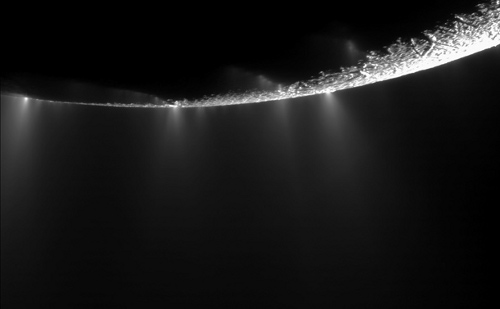Centauri Dreams
Imagining and Planning Interstellar Exploration
SETI: Contact and Enigma
I’m not surprised that Michael Chorost continues to stimulate and enliven the SETI discussion. In his most recent book World Wide Mind (Free Press, 2011), Michael looked at the coming interface between humans and machines that will take us into an enriched world, one where implants both biological and digital will enhance our experience of ourselves and each other. You’ll recall that it was a cochlear implant that restored hearing to this author, and doubtless propelled the thinking that led to this latest book. And it was the issue of hearing and communication that we looked at in an earlier discussion of Chorost’s views on SETI.
That conversation has continued in Michael’s World Wide Mind blog, as he ponders some of the comments his earlier ideas provoked on Centauri Dreams. In particular, how would we ever come to understand an extraterrestrial civilization if it differed fundamentally from us? Chorost thinks the problem is not biological, that no matter how aliens might look, we could study them to understand how they function. What would be far more tricky are questions of technology and culture, and here he brings into play Ken Wilber’s ideas about evolutionary development, notions that can be summarized in the chart immediately below.
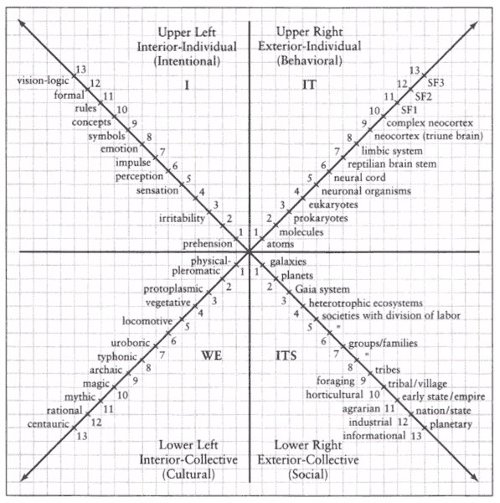
Image: Based on Ken Wilber’s ideas of an ‘all-quadrants, all-levels’ model of evolutionary development, this chart shows four axes that trace the development of a society. Credit: Ken Wilber via Michael Chorost.
If you browse through the diagram, you’ll note the likelihood that a society at level 10 on one axis will be at level ten on the other three. Chorost explains:
For example, level 10 in the upper-left quadrant is conceptual thinking. It’s aligned with level 10 in the other quadrants, which are the complex neocortex, the tribe/village, and magical modes of thought. When brains developed complex neocortexes, that was when they were able to sustain the social structures of tribes and villages, along with rituals of propitiation. One could also put it the other way around: tribal structures facilitated the development of the modern neocortex. These are all intimately related and mutually constituting. Each level on each axis is dependent upon, and enables, the others.
All of which seems to make sense, but what we should be pondering are the implications of extending each axis indefinitely. An advanced extraterrestrial species could easily register well beyond 10 on the chart along all four axes, making our need to relate human experience to what we encounter that much more difficult. We may, in fact, lack the neural structures to conceptualize and analogize these advanced levels because an alien culture would have developed modes of thought based on its own experience that are too remote from our more limited grid.
It’s always fascinating to portray encounters with aliens and always a bit aggravating when they show up in Hollywood as clearly human with a few tweaks to make them seem different. But even as we fuss with the producers of such shows for their lack of imagination (or budget), we’re missing the bigger picture. The problem is that we may find our galactic neighbors to be incomprehensible on every level. Here I think, as I often do, of the Strugatsky brothers’ novel Roadside Picnic, in which alien visitors have no apparent interest in humans at all, leaving behind them artifacts that no one can figure out. Their presence tells us that we are not alone, but their departure leaves us with questions of intent — what was their purpose here, and what are the ’empties’ (the book’s term for artifacts) that the aliens have abandoned?
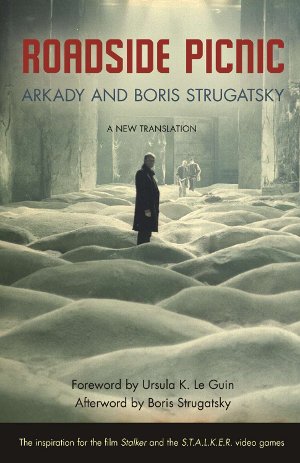
In fact, Roadside Picnic gets across the sense of the inexplicably alien better than almost any novel I have ever read — it should definitely be on the short-list for Centauri Dreams readers. The so-called ‘Visitation’ in the novel involves six different places where the aliens appeared, though they were never actually seen by people living nearby. The ‘zones’ of visitation are filled with unusual phenomena and bizarre items like the ‘pins’ found by the protagonist, who is himself a ‘stalker’ who finds and sells alien oddities like these:
In the electric light the pins looked shot with blue and would on rare occasion burst into pure spectral colors — red, yellow, green. He picked up one pin and, being careful not to prick himself, squeezed it between his finger and thumb. He turned off the light and waited a little, getting used to the dark. But the pin was silent. He put it aside, groped for another one, and also squeezed it between his fingers. Nothing. He squeezed harder, risking a prick, and the pin started talking: weak reddish sparks ran along it and changed all at once to rarer green ones. For a couple of seconds Redrick admired this strange light show, which, as he learned from the Reports, had to mean something, possibly something very significant…
But what? The novel is shot through with ambiguity and mystery. It’s the mystery of Wilber’s diagram extended indefinitely in all four directions, assuming structures of thinking that may be so far beyond our experience as to defeat our every inquiry. In human terms, we can imagine the difficulty in trying to explain sunset colors to a color-blind person. Chorost uses a much better example: The difference between a non-literate society and a literate one. Could science develop in the absence of a written language in which to couch its arguments and record its findings? And just how you would explain these questions and the need to perform these functions with language to someone who had never experienced reading or writing?
It’s possible to see ways around these problems, as Chorost explains:
I’d like to be optimistic. I’d like to think we’d be better off than preliterates puzzling over Wikipedia on an iPad. In his book The Beginning of Infinity, David Deutsch argues that humans crossed a crucial threshold with the scientific method. We now know that everything is explainable in principle, if we make the effort to understand it. Arthur C. Clarke famously said that any sufficiently advanced technology will seem like magic. This may be true, but we will not mistake it for magic. We have a postmodern openness to difference, a future-oriented culture, and well-established methodologies for studying the unknown. Our relative horizons are much larger than our ancient ancestors’ were.
I’m a bit more ambivalent. Yes, we would make every effort to explain an extraterrestrial culture. But I think that even our best methodologies will have trouble untangling motives and intent if confronted with a civilization substantially older than our own. The solution may not be in our hands but theirs (if they have hands). How concerned will they be in establishing a relationship with us? In the Strugatskys’ novel, the aliens have come and gone, leaving behind them little more than enigma. Roadside Picnic gives us a glimpse of what an extraterrestrial encounter may be like unless the culture we meet finds us worth the effort to introduce itself.

Voyager Update: Still in Choppy Waters
The continued explorations of our two Voyagers have earned these tough spacecraft the right to be considered an interstellar mission, which is how NASA now describes their journeys. Neither will come anywhere near another star for tens of thousands of years, but in this context ‘interstellar’ means putting a payload with data return into true interstellar space. Right now the Voyagers are still within the heliosphere, that great bubble opened out around our system by the Sun’s solar wind, and the signs are multiplying that a transition is soon to occur.
Three measurements are going to mark the boundary crossing, and we’re seeing that two out of the three are in a state of rapid change. This JPL news release points out that on July 28, Voyager 1’s cosmic ray instrument showed a jump of five percent in the level of galactic cosmic rays the craft was encountering. In the second half of that same day, the level of lower-energy particles flowing from inside the Solar System dropped by half. Both measurements had recovered to their former state within three days, but you can see that Voyager 1 is moving through the chop and froth that marks a boundary somewhere up ahead.
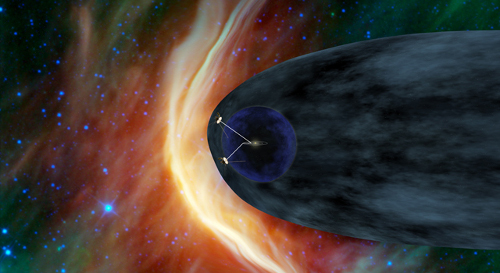
Image: The Voyager interstellar mission, pushing up against the edge of the Solar System. Credit: NASA.
The third factor is the direction of the magnetic field, which researchers expect will change direction when true interstellar space is encountered. We should have an early analysis of the latest magnetic field readings some time in the next month. At some point, all three indicators are going to switch over to a more definitive state, but even then we’ll have to see how long the back-and-forth continues in what could be a ragged boundary area.
Noting the gradual increase of high-energy cosmic rays over a period of years and the corresponding drop in lower-energy particles, Voyager project scientist Ed Stone can only say: “The increase and the decrease are sharper than we’ve seen before, but that’s also what we said about the May data. The data are changing in ways that we didn’t expect, but Voyager has always surprised us with new discoveries.” In any case, the flow of lower-energy particles is expected to drop close to zero when the final transition occurs.
As of this morning, Voyager 1, the more distant craft, is 16 hours 46 minutes and 28 seconds light-travel time from Earth, corresponding to 121.479 AU. We’re used to thinking of today’s spacecraft as being far more complex than those of previous decades, but bear in mind that the two Voyagers each contain some 65,000 individual parts, their continued functioning a testament to the skill of the scientists and engineers who designed them. What will eventually silence them is a lack of power as their radioisotope thermoelectric generators lose their punch.
Looking forward, the ultraviolet spectrometer is expected to function until mid-2013, when it will be turned off to save power. But as long as the spacecraft are still operational, the cosmic ray subsystem, the low-energy charge particle instrument, magnetometer, plasma subsystem, plasma wave subsystem and planetary radio astronomy instrument should continue to operate. We’ve got years of data return ahead and can hope for a window between the crossing into interstellar space and the loss of power around 2020 in which to see what surprises Voyager may yet spring about the environment future interstellar craft will have to move through.

After Curiosity (whew!), Thoughts on Enceladus
At $2.5 billion, NASA’s Curiosity rover didn’t cost quite as much as Cassini ($3 billion), but what a relief to Solar System exploration both near and far to have it safely down at Gale Crater. This Reuters story tells me that 79 different pyrotechnic detonations were needed to release ballast weights, open the parachute, separate the heat shield, detach the craft’s back shell and perform the rest of the functions needed to make this hair-raising landing a success. All of this with a 14-minute round-trip radio delay that left mission engineers as no more than bystanders.
Congratulations to the entire Curiosity team on this triumphant event! As we now move into the next several weeks checking the six-wheeled rover and its instruments out for exploration, let’s ponder future targets beyond the Red Planet. For at some point, no matter what we find on Mars, we’re going to want to push on to the outer planets, where intriguing moons like Titan, Europa and Enceladus await. The latter’s stock seems to be rising, as witness this recent article in The Guardian forwarded by Andy Tribick. Although they face major challenges, astrobiological missions to Enceladus offers rich prospects indeed. Two are being studied, and it’s easy to see why.
Increasingly, Enceladus seems to be a natural for astrobiology. Cassini has already shown us that the geysers spewing out of the Saturnian moon’s south pole contain complex organic compounds, and I like what NASA astrobiologist Chris McKay has to say about the place:
“It just about ticks every box you have when it comes to looking for life on another world. It has got liquid water, organic material and a source of heat. It is hard to think of anything more enticing short of receiving a radio signal from aliens on Enceladus telling us to come and get them.”
A subterranean ocean with complex organic chemicals of the sort suggested by the Cassini findings should be an interesting place indeed, especially since it seems to rise close to the surface at the south pole, accounting for the material being vented into space along the ‘tiger stripes,’ long cracks in the crust. All this material is feeding Saturn’s E-ring which, if Enceladus were suddenly to switch off, would likely disappear. McKay calls the venting of water and organics into space ‘an open invitation to go there.’
Image: Geysers at the south pole of Enceladus, as seen by Cassini in a November, 2009 flyby. Credit: NASA.
Answering the invitation would be the Enceladus Sample Return mission, a concept NASA scientists including McKay are putting together that would involve another Saturn orbiter, one that would make periodic flybys of Enceladus to collect plume samples that would eventually be returned to Earth. With Enceladus already pumping sub-surface material into space, a landing there becomes unnecessary. The Enceladus Sample Return mission builds on missions like Stardust, from which we gained expertise in retrieving sample materials from a comet’s tail. The mission is being designed to fit within the parameters of NASA’s Discovery program, which keeps the cost (without launch) at $500 million or below, about a fifth the price tag for Curiosity.
But not everyone agrees that a landing on Enceladus isn’t necessary. The German Aerospace Center (DLR) has been exploring concepts involving landing at the south pole and drilling through the ice. Its Enceladus Explorer would use an ice drill probe that would melt its way down to a depth of 100 to 200 meters to reach a water-bearing crevasse, sampling the liquid found there for microorganisms. A prototype of the device DLR is calling an IceMole has been used at the Morteratsch glacier in Switzerland and is soon to be tested in the Antarctic.
The complicated landing and drilling operation — not to mention the navigation issues faced by the IceMole as it moves through sub-surface ice — make operating the Enceladus Explorer look as risky as Curiosity’s landing on Mars. This excerpt from its project description online explains why the German team is anxious to put instrumentation on the moon’s surface and below:
…water rises to the surface through crevasses and fissures in the ice where it evaporates explosively and freezes instantly. The resulting ice fountains can shoot up to altitudes of several hundred kilometres before the ice particles slowly fall back to the moon’s surface. The microorganisms that could have evolved in the hypothetical ocean of liquid salt water under Enceladus’ icy crust, and have been swept away by the water spouting through the crevasses in the ice, would be extremely unlikely to survive; they would explode at the surface, and all that would remain are the organic compounds whose existence was verified by the Cassini spacecraft.
In other words, forget about microorganisms once they are exposed to the vacuum — all you will see are organic compounds. DLR’s IceMole, in contrast, would examine its samples in situ, sending results back to a base station on the surface that would also serve as the power source for the probe.
Would the chance to study actual living organisms give the edge to DLR’s proposal, or is a flyby the safer and cheaper alternative and the one we’re most likely to see achieved? Ideally we wind up with both missions funded, but no one would be so rash as to predict the mission choices likely from both NASA and ESA in a time of drastically reduced budgets. Let’s just say that Enceladus is staying in the news and that ingenious proposals are emerging for its study.
And it’s interesting to speculate on whether the IceMole technology being examined for DLR’s Enceladus Explorer might be adaptable to other interesting moons like Europa, Callisto or Ganymede. Each presents more problems than Enceladus, but a first-generation IceMole might some day grow into a far more powerful probe that could get a look at Europa’s deep ocean.

Habitable Worlds More Like Our Own
Gliese 581 is an utterly maddening star, one that continues to tantalize us with potential habitability. The case of Gl 581g, examined here yesterday, is only the latest wrinkle, but it’s in some ways the most frustrating. We’re studying planets we cannot actually see, inferring their presence through the tiniest of variations in starlight caused by the planets’ gravitational effect on their star. Adjust planetary orbits here in the direction of eccentricity and you can make Gl 581g disappear. Assume circular orbits and you can produce a habitable zone super-Earth.
I think we’ll still be arguing about this one for some time, but in the interim the question will lose a lot of its force. Remember, the reason we’re so excited about Gl 581g is that it would become the closest planet with the possibility of liquid water at the surface (possibly joined by Gl 581d in the same system). But Jean Schneider’s Exoplanet.eu catalog shows 777 confirmed planets this morning, and Kepler has pulled in 2,321 planetary candidates, 246 of which are 1.25 times Earth’s radius or less. In short, habitable planets are not going to be uncommon for long.
Remember, too, that while Kepler has found 46 candidates orbiting within the habitable zones of their stars, we’re soon going to be seeing truly Earth-class planets, worlds that orbit at about our planet’s distance from a star like the Sun. It takes three transits to flag one of these, but as the Kepler mission winds on, the focus will shift at least for a time from habitability around problematic red dwarf stars and on to planets so like ours that they will seize the imagination. And who knows, we may yet find something interesting around the Alpha Centauri stars, close to home indeed. Three ground-based radial velocity studies continue to probe these stars.
So let the Gl 581g controversy have its moment in the press. We should be thinking ahead to the possibilities of missions like the Transiting Exoplanet Survey Satellite (TESS), which could go to work on stars closer to the Sun than those in the Kepler or CoRoT catalogs. We have to run missions like TESS and the European Space Agency’s PLATO (PLAnetary Transits and Oscillations of stars) on the cheap in an era when the big-ticket planet hunters like Darwin and Terrestrial Planet Finder have been placed on hold, but they could at least help us fill in the nearby exoplanet catalog while we wait for better budgets and missions that will be able to detect biomarkers.
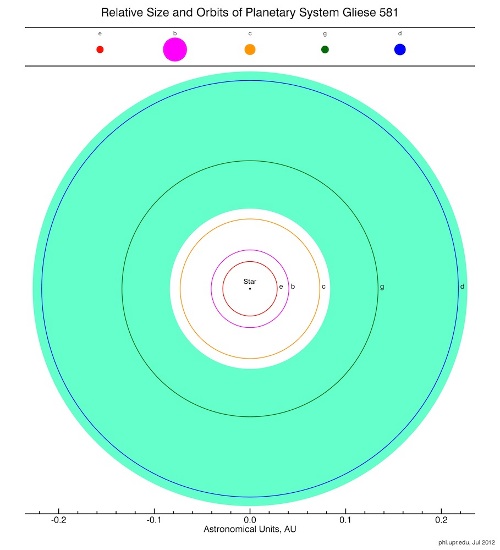
Image: Comparison of the estimated relative size and orbits of the five possible exoplanets around Gliese 581. The green shade represents the size of the habitable zone, or the orbital region where an Earth-size planet could have surface liquid water. Planets e, b, and c are too hot for liquid water and life but g and d are in the habitable zone. Planet g is specially in the right spot for Earth-like conditions while d is marginally within these limits, and colder. This is the first case of a stellar system with two potential habitable exoplanets orbiting the same star, assuming Gl 581g exists. Credit: Planetary Habitability Laboratory/University of Puerto Rico at Arecibo.
While we wait, consider that the five possibly habitable exoplanets shown in the illustration for yesterday’s post are all fairly large. The disputed Gl 581g, if it exists, is at least twice as massive as the Earth, while its sister world Gl 581d is seven times as massive and, as the image above shows, orbits at the extreme outer edge of the classical habitable zone. Kepler-22b — the first known transiting world to orbit inside the habitable zone — looks to be about 2.4 times as wide as the Earth with a mass only roughly estimated at something like Neptune’s.
The above are among the five planets chosen by the Planetary Habitability Laboratory of the University of Puerto Rico at Arecibo as ‘the best five objects of interest for Earth-like exoplanets,’ a list that within months will be undergoing convulsions as new discoveries are announced. About Gl 581g, PHL’s Abel Méndez says “The controversy around Gliese 581g will continue and we decided to include it to our main catalog based on the new significant evidence presented, and until more is known about the architecture of this interesting stellar system.”
Fair enough, and PHL also adds two other interesting worlds. HD 85512b is a super-Earth about 3.6 times as massive as the Earth some 35 light years out, while Gl 667Cc is 4.5 times as massive as the Earth, orbiting a red dwarf some 22 light years out that is part of a triple-star system. Those distances are right in the neighborhood compared to Kepler-22b’s 600 light year distance, but we can expect even closer worlds as our studies continue. After all, as Kepler chief scientist William Borucki told The Economist in a recent article:
“The data so far suggest that most stars have planets, and we see quite a few of those in the habitable zone. So I suspect there’s nothing particularly special about planets at such distances.”
Dr. Borucki is surely right, and we should also keep in mind that we’re getting better and better at finding smaller planets. A few years from now, our five top prospects for habitable worlds are all going to look a lot more like the Earth.
Meanwhile, we enter the weekend with all eyes on a search for habitability much closer to home. Gale Crater on Mars has the advantage of being accessible — assuming the Curiosity rover’s elaborate landing system delivers it safely — and ideal for analysis by the rover’s high-tech laser and drill, along with its instruments for studying atmospheric methane. Finding solid evidence of life, past or present, on Mars is not crucial for the exoplanet hunt, but I suspect that its discovery would give a lift to those seeking habitable planets around other stars. Show us a nearby ‘second genesis’ and our thoughts will soar to the billions of habitable worlds that fill the galaxy.

Gl 581: The Case for Habitable Planets
Not long ago, while making a presentation about possible destinations for an interstellar probe, I called Gl 581d the most likely candidate for habitability yet discovered among nearby stars. I knew the planet was problematic, perhaps too far on the outer edge of the habitable zone to be a realistic candidate, although this seems to depend on a variety of factors including atmospheric modeling. But what I had really been pondering in deciding whether or not to include Gl 581d in the talk was whether its purported sister world, Gl 581g, should be brought into play.
Steven Vogt (UC-Santa Cruz) and colleagues were getting ready to distribute their new paper making a further case for a super-Earth in the habitable zone, one that seemed to be ideally placed for liquid water to exist on the surface. Bring that into the discussion?
I decided against it, because the controversy over this world continues and Centauri Dreams seems a better venue than a short public talk to get into the details. Let’s begin here, then, with Michel Mayor and the Geneva team, who had already identified four planets in the system, including Gl 581c, itself a target of speculation about whether or not it might be in the habitable zone. But Gl 581c looks to be too hot to support life, leading to the renewed interest in Gl 581d. This work was accomplished using data from the HARPS spectrograph on ESO’s 3.6m La Silla instrument.
What Vogt and team did in 2010 was to combine the earlier HARPS data with 122 additional measurements made using the HIRES spectrometer at the Keck Observatory on Mauna Kea. It was from this combined dataset that Vogt drew evidence of two new planets: Gl 581f (with an orbital period of 433 days) and Gl 581g, with a period of 36.5 days. It wasn’t long after this that Francesco Pepe (Observatoire de Genève) added another 60 HARPS measurements to the earlier ones and announced his team could not confirm the presence of either of the two worlds Vogt had found. In his new paper, Vogt’s team questions whether Gl 581f or Gl 581g would have been detectable using the 179-point HARPS data set on its own.
I’m moving through the details here quickly — the paper is available on the arXiv site and I encourage you to look at it. But new work by Thierry Forveille (Institut de Planetologie et d’Astrophysique de Grenoble) added another full observing season of HARPS data and still found no trace of Gl 581f or Gl 581g. It’s this set of expanded HARPS radial velocity data that Vogt’s new paper goes to work on, and it reaches a significantly different conclusion (F11 in the excerpt below refers to Forveille’s paper):
… we have shown in the present work that the F11 Keplerian solution is dramatically unstable over a wide range of starting conditions, and is thus untenable. F11’s conclusion of there being only four planets in the system was based on this unphysical model and can thus be discounted. Furthermore, the data points that were apparently omitted from the F11 analysis were dropped solely based on deviation from their 4-planet model, thus unfairly and specifically suppressing evidence for any additional planets in the system.
Things are, as you can see, heating up. What Vogt is talking about is that his simulations of the Forveille Keplerian models — with the Gl 581 planets in eccentric rather than circular orbits — showed that these orbits were unstable. This is important because Forveille used the Keplerian model in assessing the likelihood of the existence of Gl 581f and Gl 581g. In fact, among 4000 eccentric orbit simulations, not one survived beyond 200,000 years, with only 24 surviving for at least 20,000 years. All 4000 simulations ended with a collision between the two inner planets. By contrast, all 4000 simulations based on circular orbits turn out to be stable for at least 100,000 years.
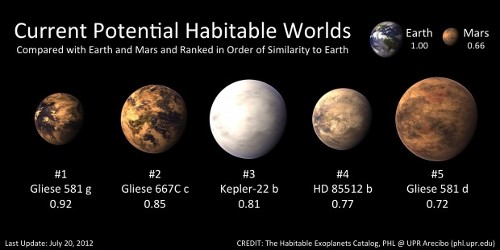
Image: Artist’s conception of five potentially habitable exoplanets, with Earth and Mars to scale. Credit: The Habitable Exoplanets Catalog, PHL @ UPR Arecibo.
Using stable, circular orbits for its modeling, Vogt’s team sees a fifth planet (V10 below refers to Vogt’s 2010 paper):
Contrary to F11’s conclusions, we find that the full 240-point HARPS data set, when properly modeled with self-consistent stable orbits, by and of itself actually offers confirmative support for a fifth periodic signal in this system near 32-33 days, and is consistent with the possibility of having been detected as GJ 581g at its 36-day yearly alias period by V10. The residuals periodograms both of our interacting and non-interacting fits and of the F11 four-planet circular fit reveal distinct peaks near 32 days and 190 days. Both of these residuals peaks are largely simultaneously accounted for by adding a fifth planet at 32.1 days to the system.
According to Vogt, we wind up with a planet with minimum mass of 2.2 times that of Earth orbiting at 0.13 AU, “solidly in the star’s classical liquid water Habitable Zone.” That, at least, is what the data analysis produces if we assume circular orbits of the four known planets and work out the reasons for the further perturbations that Vogt’s team sees as evidence for a fifth planet. Vogt believes a 5-planet model with all circular orbits trumps a 4-planet model with eccentric planetary orbits, but adds that it may take time and further data to give a definitive answer.
What to make of all this? Gl 581 is offering us an instructive example of how tricky exoplanet analysis can be. Here we’re looking at radial velocity data showing Doppler shifts in the light of the star that result from the gravitational pull of multiple planets orbiting it. You can see how complicated a problem this is, and how multiple solutions can suggest themselves. I find myself pulling for Vogt’s team because I want a planet in the habitable zone to exist somewhere near our Sun (Gl 581 is about 20 light years from us), and the new paper is compelling. But we haven’t heard the last of this exoplanet flap, and how it will end is anyone’s guess.
The paper is Vogt et al., “GJ 581 update: Additional Evidence for a Super-Earth in the Habitable Zone,” accepted for publication in Astronomische Nachrichten (abstract). The Forveille paper is “The HARPS search for southern extra-solar planets XXXII. Only 4 planets in the Gl~581 system,” submitted to Astronomy & Astrophysics (abstract).

Habitable Worlds around White Dwarf Stars?
Not all that long ago we assumed habitable planets needed a star like our Sun to thrive, but that view has continued to evolve. M-class red dwarfs may account for as many as 80 percent of the stars in our galaxy, making habitable worlds potentially more numerous around them than anywhere. And let’s extend our notion of habitability to what Luca Fossati (The Open University, UK) and colleagues call a Continuous Habitable Zone (CHZ). Now things really get interesting, for a red dwarf evolves slowly, so planets could have a CHZ with surface water for billions of years.

But what about white dwarfs? Stellar evolution seems to rule out habitable worlds around them because we normally think of stars entering their red giant phase and destroying their inner planets enroute to becoming a white dwarf. But can a new planetary system emerge from the wreckage? We’ve already found planets orbiting close to the exposed core of a red giant (KOI 55.01 and KOI 55.02), showing that the end of main sequence evolution isn’t necessarily the end of planetary survival. We’ve also found evidence in the metallic lines in the spectra of white dwarfs for rocky bodies close to such stars, a kind of ‘pollution’ thought to be caused by the accretion of small, rocky worlds or perhaps planetesimals (see Planetary Annihilation Around White Dwarfs for more).
Image: Almost all small and medium-size stars will end up as white dwarfs, after all the hydrogen they contain is fused into helium. Near the end of its nuclear burning stage, such a star goes through a red giant phase and then expels most of its outer material (creating a planetary nebula) until only the hot (T > 100,000 K) core remains, which then settles down to become a young white dwarf which shines from residual heat. Credit: Jonathan Saurine/Science Vault.
The conditions on planets orbiting close to a cool white dwarf might be relatively benign. What Fossati and team show is that the cooling process in these stars slows down as their effective temperature approaches 6000 K, producing a habitable zone that can endure up to eight billion years. And it turns out that white dwarfs offer advantages M-dwarfs do not, providing a stable luminosity source without the flare activity we associate with younger M-class stars. As you would expect, a cool white dwarf has a habitable zone close to the star, ten times closer than for M-dwarfs. One recent study has used this to argue that a Mars-sized planet in the white dwarf CHZ would be detectable with today’s ground-based observatories even for faint stars.
But there are other options including polarized light that may be used to detect a planet with an atmosphere around a white dwarf. Normally, starlight is unpolarized, but when light reflects off a planetary atmosphere, the interactions between the light waves and the molecules in the atmosphere cause the light to become polarized. The paper notes that the polarization due to a terrestrial planet in the CHZ of a cool white dwarf would be larger than the polarization signal of a comparable planet in the habitable zone of any other type of star except brown dwarfs. Analyzing polarization is thus a viable way to detect close-in rocky planets around white dwarfs.
Would the ultraviolet radiation put out by a white dwarf disrupt the formation of DNA molecules? Fossati and company created a computer model to study the DNA dose expected for an Earth-like planet in the white dwarf habitable zone using an Earth atmosphere model. The result:
The DNA-weighted UV dose encountered at the surface of an Earth-like planet in the white dwarf CHZ becomes comparable to that of an exoplanet in the habitable zone of a main sequence star at approximately 5000 K. Interestingly, present-day solar conditions produce an average dose on Earth a factor of only 1.65 less than that for a white dwarf with solar Teff [effective temperature]. Varying terrestrial atmospheric conditions at times produce DNA-weighted doses on Earth as high as that on a CWD planet… [T]he DNA-weighted dose for a hypothetical Earth-like planet around a CWD is remarkably benign from an astrobiological perspective, for an extremely long period of time.
So white dwarfs, the remnants of those stars not massive enough to become a neutron star, may provide us with interesting venues for life. We can even imagine a typical star going through its pre-red giant phase with a planetary system nurturing life and then, after the red giant phase is complete, beginning a post Main Sequence astrobiological phase with a planetary system in a new configuration. The notion is plausible on the strength of this paper, though the researchers point out that 10 percent of all white dwarfs host magnetic fields that could be problematic for life. This paper assumes the hosting white dwarf is a non- or only weakly magnetic star.
The paper is Fossati et al., “The habitability and detection of Earth-like planets orbiting cool white dwarfs,” accepted for publication in Astrophysical Journal Letters (abstract). Thanks to Adam Crowl for the pointer. For more on planets around red giants, see Planets Survive Red Giant Expansion.

